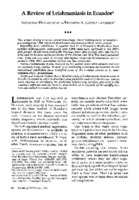Cutaneous leishmaniasis in subtropical Ecuador: popular perceptions, knowledge, and treatment
Fecha
1994Metadatos
Mostrar el registro completo del ítemResumen
Popular perceptions and knowledge about cutaneous leishmaniasis and its treatment were studied in an endemic area of subtropical Northwest Ecuador. Although most of the adults surveyed were familiar with the disease, the vector, and traditional treatments, many showed a lack knowledge about transmission of the disease, ulcer healing, and conventional treatment. Gender was found to have a significant impact on disease risk, perceptions, and treatment knowledge. Males experienced a risk of contracting cutaneous leishmaniasis that was almost triple that of women. Men were also more likely to perceive that the disease seriously diminished the victim's capacity to work. Women, on the other hand were more prone to perceive that cutaneous leishmaniasis was a serious disease that significantly decreased self esteem. Although 80 percent of the subjects knew at least one method of treating the disease, women tended to know more methods than men. Most of 150 different therapies reported involved the use of indigenous plants, chemical, acids, antibiotics, heat treatments, or petroleum by products. Some of these treatments could have clinical value. However, only 7 percent of the subjects knew about pentavalent antimonials. Almost 70 percent of the subjects with a past or present infection history were treated solely by traditional methods; only 12 per cent received a full course of Glucantine, while 7.5 percent got an incomplete course. The findings indicate that it will be important to consider the identified gaps in knowledge and gender perceptions regarding the disease and its treatment when planning future control programms This article will also be published in Spanish in the BOSP. Vol. 117, 1994
Colecciones
Ítems relacionados
Mostrando ítems relacionados por Título, autor o materia.
-
Pan American Health Organization; Communicable Diseases and Environmental Determinants of Health (CDE) (PAHOUnited StatesWashington, D.C., 2020)In the Region of the Americas, the leishmaniases are a group of diseases caused by various species of Leishmania, which cause a set of clinical syndromes in infected humans that can involve the skin, mucosa, and visceral ...
-
Hashiguchi, Yoshihisa; Gómez Landires, Eduardo A (1991)This article briefly reviews current knowledge about leishmaniasis in Ecuador-proceeding from 1920, when the first human case was described, to the present. Regarding basic conditions, it appears that 14 of Ecuador's 20 ...
-
Egger, Matthias; Ferrie, Jane; Gorter, Anna; González, Silvia; Gutiérrez, Roberto; Pauw, Johanna; Smith, George Davey (1993)In 1990, the AIDS-related knowledge, attitudes, and practices of fifth year (final year) students at four Managuan high schools were assessed. This was done by means of a self administered questionnaire completed by 451 ...



